There are a lot of wild pigs on D’Urville Island, I mean heaps. Whole swaths of hillside have been churned over by their noisy, nosey snouts. In fact, they sometimes reach such multitudes, that the delicate native bush regrowth looses all hope of standing their way.
Not that it’s entirely their fault, mind you—they’re just happy living their wild pig way. Surely, the blame lies with the settlers of old who brought them over in the first place? Introducing a persistent scavenger into a lush wilderness was only going to end one way! But playing the blame game changes nothing now, and it remains a fact: there are lots of wild pigs on D’Urville Island.
This is why there are also a lot of pig traps here—they help with efforts to keep the numbers down, pastures and vegetation intact, and, for those who like to eat them, they offer free food for the table.
(For the record, the pig traps I’m talking about are the enclosed pen type—with a trapdoor mechanism that allows a pig to get in, but not out again—not the hideous, jaws-of-death type).
Positioned at the top of our valley is just such a trap, a solid outfit of wire mesh and wooden posts and, out of curiosity—and a desire to fend from the land as much as possible—we decided to try our hand at catching a pig.
But, for all their numbers, it turns out trapping one is not as easy as we first imagined!
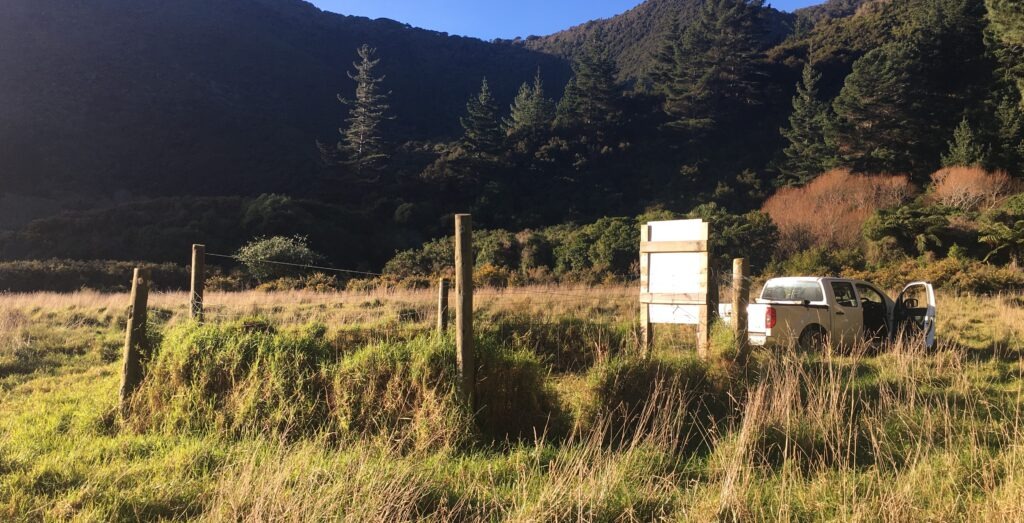
Day 1:
First, we needed bait — and the smellier the better!
Sometimes I have to admire the synchronicity of the universe. We were visiting a friend over on a neighboring farm when she randomly got chatting about her miraculous, catch-all pig bait: feijoas. Now, standard practice is to use meat scraps, offal or entrails, hunting leftovers etc. (pigs are omnivorous scavengers), but her theory was that they already have a lot of meat in the bush, and fruit is what they’re really craving.
So, taking that tip in hand, we conducted a raid on our property’s shared compost bin. Sadly, no feijoas, but deep in the depths we did find a couple of half-rotten melons. Would they be smelly enough?
To cover all bases, we threw in some decomposing fish scraps (which, in the name of all things utterly repulsive, were certainly smelly enough!) and headed confidently up the valley—with windows closed! (the bait-bucket-of-shame was exiled to the ute tray).
Setting the trap:
First, we piled up the bait in a tasty mound just beyond where the tripwire sits.
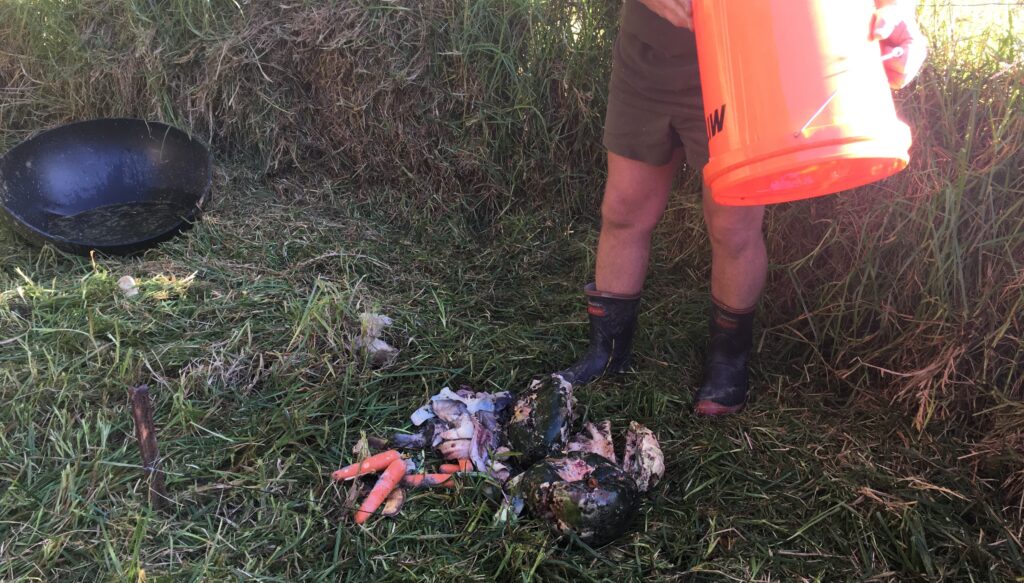
(Notice how it was Danny who tipped the bait out—not surprisingly the kids ran a mile!)
Next, Sol laid out the tripwire, hooking one end onto the top of a short metal stand, and then running the length of it tightly over to the fence.
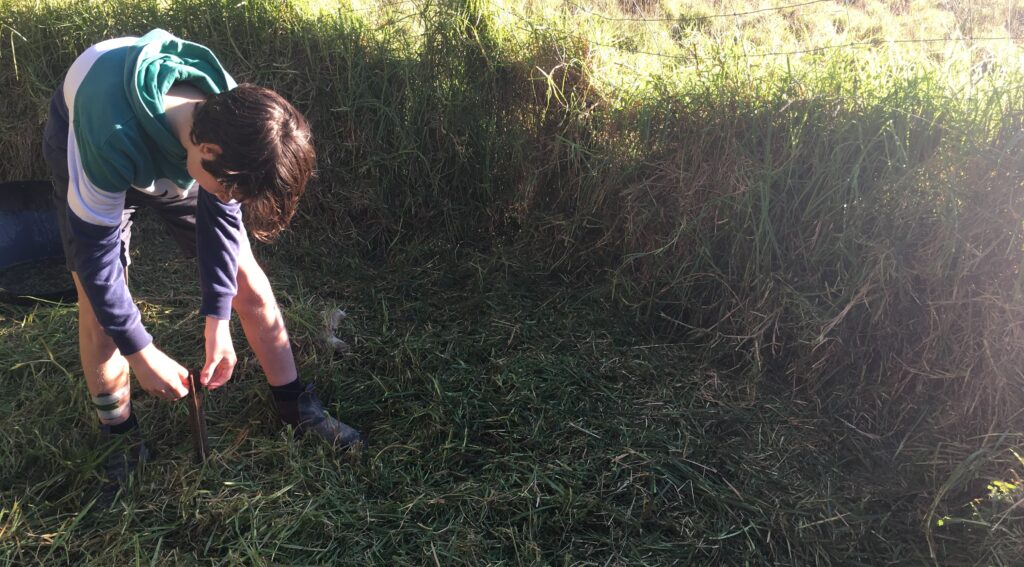
Finally, we slid the pin at the end of the tripwire into the loop at the end of the rope that holds the gate up. With this small pin in place, the rope was held tight and the gate held open.

Now, if anything disturbed the tripwire, the pin would be yanked out of the ring, releasing the rope and thereby slamming the gate shut. That was the theory anyway.
I had to marvel at the set up—it was so simple, yet so clever. It reminded me of something a cartoon character might cook up to catch the bad guy! But this was our cunning plan, to catch an unsuspecting pig lured in by the smell of melon.
We headed home buoyed with confidence. Surely this would be easy-peasy—maybe we’d even get two?
I’m not sure that up until this point I’d really thought about the reality of catching a pig. I knew what the outcome would be: meat on the table for a while. But on the drive back down the valley, I wondered how I’d feel about this. Is it more respectful to catch and kill a wild animal, than to farm it and serve it up at the supermarket clinically wrapped in plastic? I would like to think so. It’s far more real at any rate.
Day 2:
Early next morning, Rowan (always first to wake) raced a little way up the valley to spy on the trap from afar. He had promising news: the gate was down!
Unravelling from sleep, we cranked into action. Danny gathered his rifle and ammunition and we all piled back into the ute. As we approached, we were mindful of not scaring any trapped animals, so we parked at a distance and crept the rest of the way on foot.
When we got really close, the boys and I stopped and focused on breathing quietly while Danny went in for a solo look.

The boys and I watched and waited. How long does it take to spot a pig in a pig trap? By the time Danny’s head swung around for a second sweep I knew we hadn’t caught anything. But the gate had been down? We waded through the grass to check the verdict.
And it turns out something had been in there. The tripwire was all churned about, the bait had been nibbled, and the grass had been flattened. But whatever it was, it had gotten out unimpeded by the shut gate. Hmm.
We decided to try our luck a second time, clearly there was something interested in all that loot. This time though, we moved the bait over to make it less likely for a small animal to catch the tripwire.
Day 3:
With almost the same enthusiasm as the day before, Rowan came in to tell us the gate on the trap was down, again. Hopeful though we were, we were a bit slower at loading into the ute, and a little less cautious to make no noise going up to check the trap.
Within a few seconds of Danny’s head peering over the fence I knew again there was nothing to show for the night’s rummaging. What was getting into the trap? Hawks? Some type of rare pigmy piglet? We bandied some theories around, each getting a little more unlikely, but inevitably it remained a mystery.
There was nothing left to do but set the trap a third time, if not even to catch a pig, but to try and figure out who, or what, we were inadvertently feeding! We fiddled around with the tripwire for a while, lifting it as high as it would go, again, to try and prevent it from being sprung by smaller interested parties.
We headed home, again.
Day 4:
By this time, it fell to me to check the gate from afar—Rowan was busy doing more interesting things. And when, sure enough, I found it down, it was only me and Danny who climbed into the ute to go up the valley. Would it be third-time lucky?
It was actually our lack of caution that ended up giving us a semblance of a conclusion to the whole venture.
Because, feeling less than hopeful, this time we decided to drive all the way to the gate. And that was when everything became apparent in the dark sleek blur that darted out from between the wire mesh. It was a Weka. Caught in the act.

Fun fact: as well as wild pigs, there are also a lot of Wekas on D’Urville Island. And, as with all scavengers, there is intelligence in those eyes, as they strut about like small, feathered raptors, stealing-in on any scraps of food like bandits.
They’d clearly been having a grand time feasting on all the goodies we’d left them. What’s more, after springing the trap and shutting the gate, they would have been able to gorge uninterrupted from any common pig!
We took a moment to survey the trap and, with a sinking feeling, realised that weka-proofing it would require a bit of an overhaul. The best method would be to permanently set the tripwire higher so that wekas would slink underneath without catching it. As things were, we could persevere—indeed we have it on good authority that pigs have been caught in this trap before—but we would be fighting the odds (or the wekas!)
Later, someone patiently explained that the sure-fire way to lure in pigs is to use maize and raspberry jam. Just like fishing, it seems that everyone has their secret tricks and tips.
But, whilst we are keen to sample all the adventures that Island life can throw at us, we’re happy to leave the pigs roaming free for a little while longer. We certainly aren’t starving and, all things considered, maybe it’s only fair!
- Why the Mumma learned to motorbike

- From Private Bag to doorstep: the epic journey of our mail
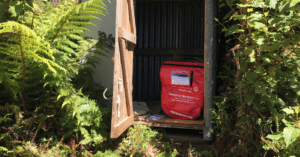
- Sourcing our drinking water from the top of a waterfall—now that’s refreshing!
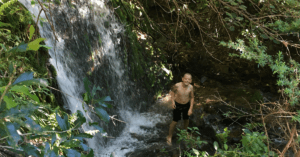
- How to hang out washing in 60 km/h winds
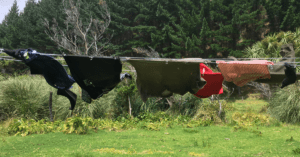
- We found the best use for a mussel buoy—ever!
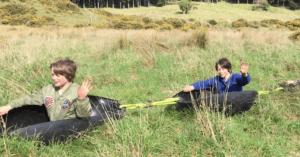
- What we caught in the pig trap (hint: It wasn’t a pig!)


